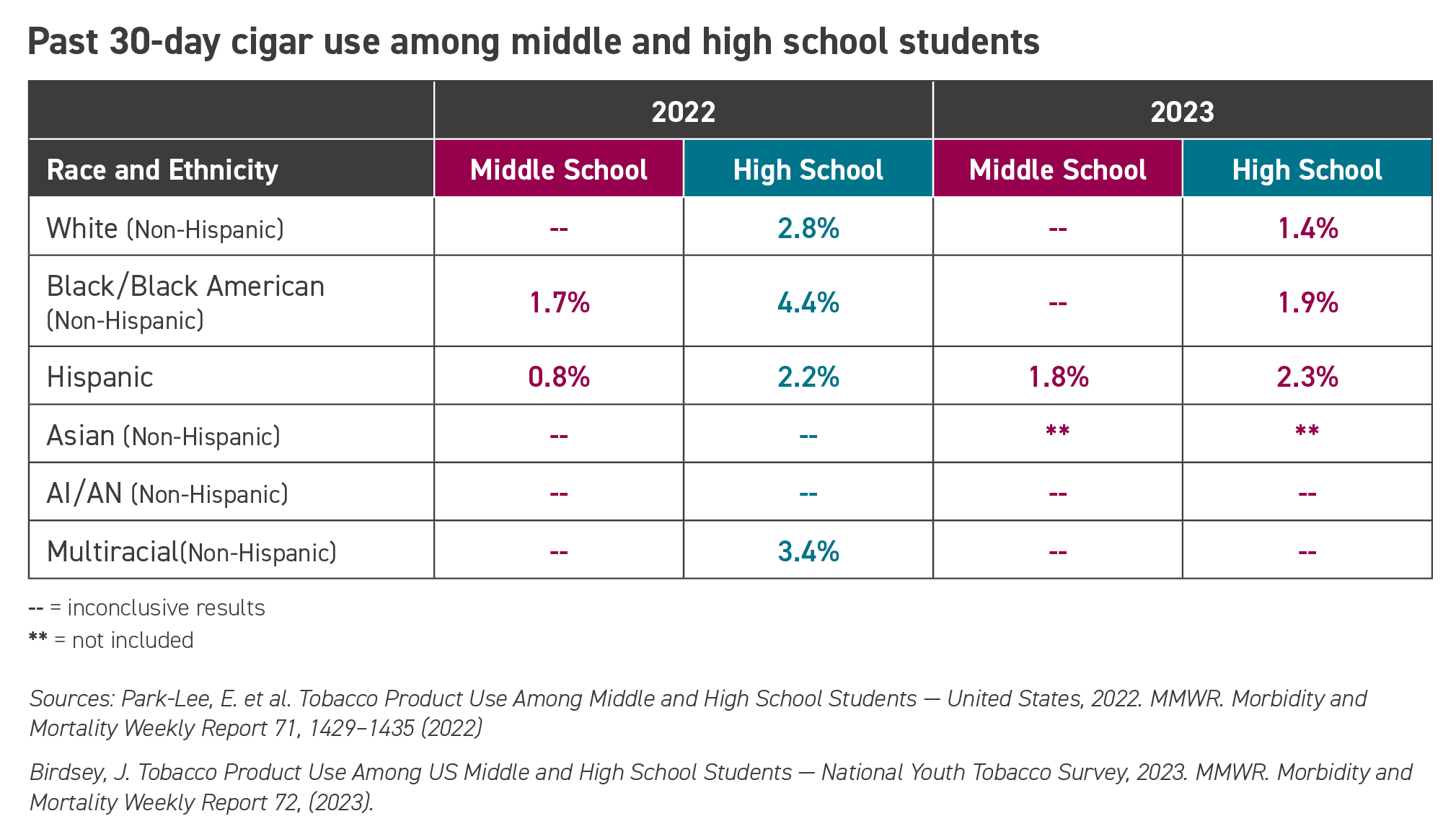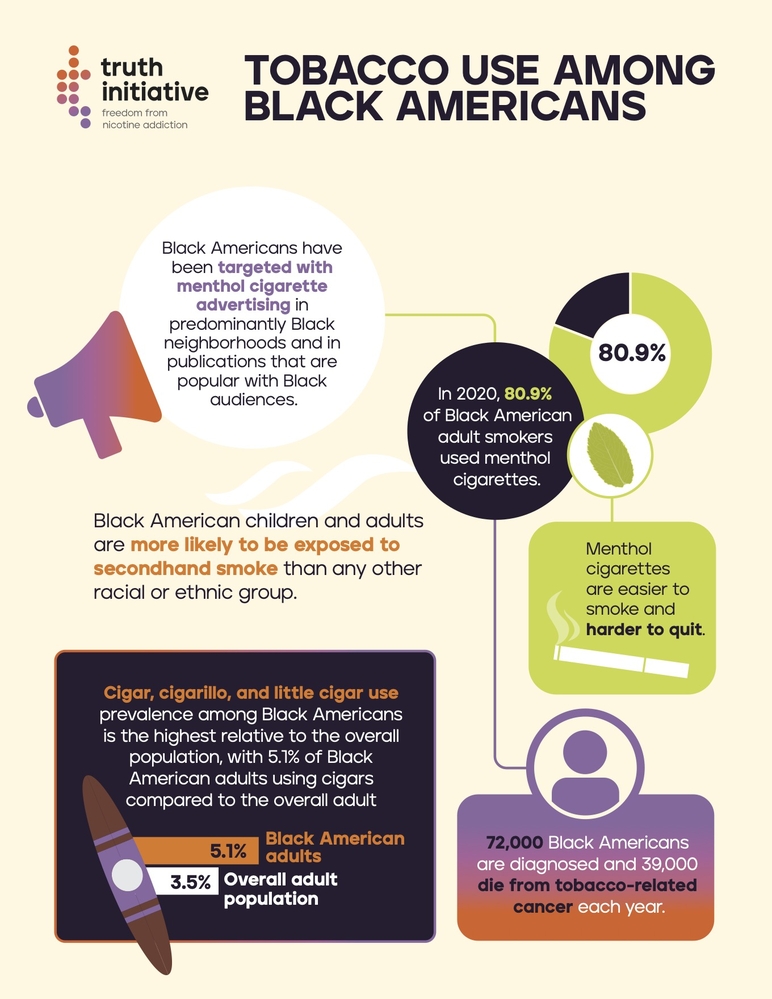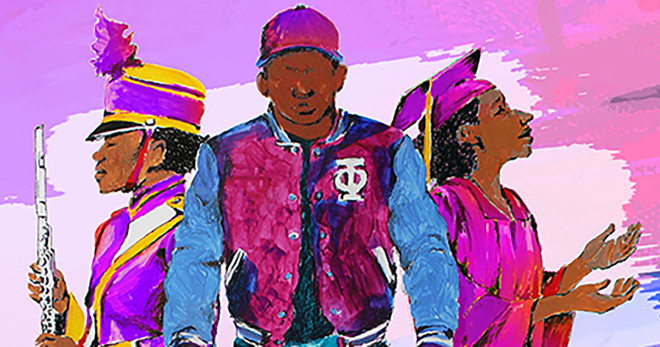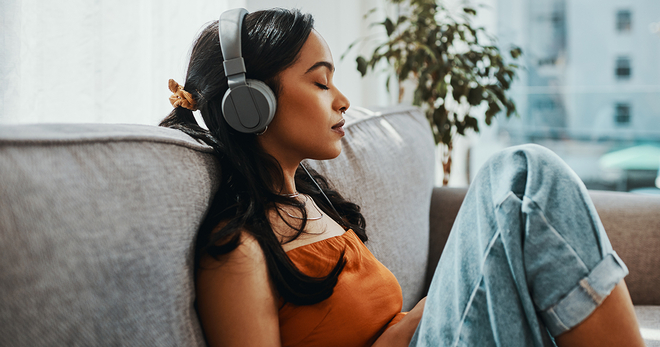Tobacco use in the Black American community
Background
Black Americans have a higher prevalence of smoking compared with other racial and ethnic groups, and they are disproportionately affected by tobacco use in several ways. For example, Black Americans have higher death rates from tobacco-related causes and are more likely to be exposed to secondhand smoke.
The tobacco industry has targeted Black Americans and strategically marketed its products to appeal to the community for decades, including by placing more advertising in predominantly Black neighborhoods and in publications popular with Black audiences. The most striking example is menthol cigarettes, which are easier to smoke and harder to quit. Today, 80.9% of Black American smokers use menthol cigarettes, and about 45,000 Black Americans die from smoking-related disease each year. Experts believe that racial differences in socioeconomic factors and secondhand smoke exposure may play a role.
Patterns of use in the U.S.
CIGARETTES
Youth
- According to the 2020 National Youth Tobacco Survey, the current cigarette smoking prevalence was 2.8% among Black American high school students compared with 4.6% of all high schoolers.
- According to the 2021 National Youth Tobacco Survey, the current cigarette smoking prevalence among Black American middle schoolers was 1.1% compared with 1.0% of all middle schoolers.
Adults
- In 2021, 11.7% of Black American adults were current smokers, compared to 11.5% of American adults overall.
MENTHOL CIGARETTES
Menthol is a chemical compound either extracted from peppermint or corn mint plants or created synthetically. It reduces the harshness of cigarette smoke due to its characteristic cooling effects on the mouth and throat. It also suppresses the coughing reflex, which makes inhaling smoke from cigarettes more tolerable. Black Americans have a higher prevalence of menthol tobacco use than other racial and ethnic groups.
Adults
- In 2019, 80.9% of Black American adult smokers used menthol cigarettes, compared to 43.4% of adult smokers overall.
- Black American smokers have disproportionately used menthol cigarettes for decades. As a result, between 1980 and 2018, menthol cigarettes were responsible for 1.5 million new smokers and 157,000 deaths among Black Americans.
Youth
- In 2018, more than half (51.4%) of Black American middle and high school students who smoked used menthol cigarettes, compared with 50.6% of Hispanic smokers and 42.8% of White smokers.
Black American youth continued to have higher past 30-day menthol cigarette use compared to other races (56% vs. 47%) between 2018–2020.
Research shows that Black American smokers start to smoke later compared to those of other races. However, Black American adults who smoke menthol cigarettes are less likely to quit compared to other races and have lower quit rates than Black Americans who smoke non-menthol cigarettes.
The FDA recognized the harm menthol is causing to public health and announced plans to remove menthol cigarettes and all flavored cigars from the market in 2021. Despite public support (62.3%) for the menthol cigarette proposed rule, the proposal was delayed indefinitely in April 2024. When presented with a hypothetical flavored tobacco restriction in two separate studies, Black American menthol smokers were less likely to switch to non-flavored smoking or more likely to quit if flavors like menthol were removed. More information on the impact of menthol can be found in our menthol fact sheet.
Little cigars, cigarillos and cigars
Black Americans have the highest prevalence of cigar use. Cigars include a variety of products, including traditional large cigars, longer and slimmer versions of large cigars called cigarillos, and little cigars, which are like cigarillos but generally have a filter like cigarettes. Cigars, particularly little cigars and cigarillos, come in a variety of flavors. Research shows that flavored tobacco products, including flavored cigars, cigarettes, and e-cigarettes, have enormous appeal to young people.
Youth
- Among Black American high school students, cigars were the second most common tobacco product used (1.9%) after e-cigarettes (5.6%) in 2023.
- Black American middle and high school students had the highest prevalence of cigar use compared to other races in 2022.
- Black American high school students had nearly twice the prevalence of current cigar use (4.4%) compared to their White classmates (2.8%) in 2022. Black American high school students had lower prevalence of cigar use in 2023, yet still had the second highest current use prevalence (1.9%), following Hispanic American students (2.3%).
- Among Black American middle school students, 1.7% were current cigar users in 2022, compared to 1.4% in 2021.
Adults
- Black American adults ages 21+ were more likely to report past 30-day cigar use compared to their White counterparts, according to analysis of data from National Survey on Drug Use and Health.
- Past 30-day cigar smoking prevalence for Black Americans ages 21+ increased from 6.7% in 2002 to 8.6% in 2019 despite declines in cigar smoking prevalence among their White and Hispanic American peers, according to analysis of data from the National Survey on Drug Use and Health.
- 5.1% of Black Americans ages 18 and over used cigars “every day” or “some days,” according to the 2021 National Health Interview Survey.

E-cigarettes
E-cigarette use has continued to increase among Black American middle school youth. Between 2021 and 2023, current e-cigarette use among Black American middle school students more than doubled from 2.3% to 5.7%. High school e-cigarette use increased from 5.9% in 2021 to 11.1% in 2022 before declining to 5.6% in 2023.
Youth
- Among Black American youth, 5.6% of Black American high school students and 5.7% of Black American middle school students used e-cigarettes in 2023. While this is lower than current e-cigarette use among all high school students (10%), it is higher compared to e-cigarette use among all middle school students (4.6%).
Adults
- Black American adults had the lowest prevalence of e-cigarette use (2.4%) compared to White (5.2%), Hispanic (3.3%), and Asian American (2.9%) adults, according to the 2021 National Health Interview Survey.
Secondhand smoke
Black American children and adults are more likely to be exposed to secondhand smoke/environmental tobacco smoke than any other racial or ethnic group. The U.S. Surgeon General has concluded that there is no safe level of exposure to secondhand smoke.
Black American nonsmokers generally have higher cotinine levels (an indicator of recent exposure to tobacco smoke) than nonsmokers of other races and ethnicities.
Industry targeting
Evidence from tobacco industry documents shows that tobacco companies have a long history of targeting Black Americans with menthol cigarette advertising and have made large financial contributions to Black groups and political leaders.
- Historically, Big Tobacco companies like United States Smokeless Tobacco Company and Phillip Morris have targeted Black Americans. They have exploited Black media and cultural groups by putting coupons and advertisements in Black magazines, such as Jet and Ebony, and using Black fraternities to distribute promotional materials.
- A 2013 study found that Black American children were three times more likely to recognize advertisements for Newport brand menthol cigarettes than other children.
- A study found that as a high school’s Black American student population increased, the odds of promotions for the menthol brand Newport went up and the cost of Newport packs went down in the neighborhood.
- A study found that Newport print advertising in 2012 and 2013 placed in magazines targeting Black Americans and younger consumers relied on themes of sociability and sexuality.
- A 2016 study found that a decrease in tobacco marketing with Black models in Black magazines like Jet, Ebony, and Essence was correlated with decreasing smoking initiation among Black Americans from the late-1970s to the mid-1980s.
- Several studies have found a greater number of tobacco advertisements and a larger presence of tobacco advertising in Black neighborhoods.
- Studies in 2015 and 2018-2019 found that neighborhoods with a larger Black American population had a higher chance of exterior advertisements and price promotions and greater chance of availability of flavored cigar products, including little cigars and cigarillos.
- Newport, a prominent menthol tobacco brand, had almost twice as many price promotions and cheaper prices in neighborhoods with a greater Black youth population.
- Disparate availability of tobacco also extends to schools. Schools in non-rural areas with a higher Black student population are closer to stores that sell tobacco compared to schools with higher white student populations, according to a 2023 study.
- Tobacco companies have used experiential marketing — the tactic of encouraging consumers to experience or interact with a brand at recreational venues and events such as concerts, bars, or nightclubs — to specifically target certain populations, including Black Americans.
- Tobacco companies have paid Black leaders to speak on their behalf, spreading fear that a rule to eliminate menthol products would unfairly target Black Americans and would lead to further criminalization of the community. However, The FDA has repeatedly stated that enforcement of the rules would be focused on manufacturers and retailers, not individual consumers.
- R.J. Reynolds, the maker of the leading menthol brand Newport, recruited prominent Black leaders including civil rights activist Rev. Al Sharpton to host town halls where fear and misinformation regarding the elimination of menthol cigarettes spread.
- Rev. Horace Sheffield, a pastor with Detroit's New Destiny Christian Fellowship whose mother smoked menthols and died from a heart attack when the reverend was young, refused to accept tobacco industry funds when RJ Reynolds asked him to advocate on their behalf.
Health effects
- Smoking is a major cause of heart disease and cancer, which were the top two leading causes of deaths for Black Americans in the U.S. in 2020.
- Smoking is responsible for about 30% of all cancer deaths. Lung cancer is the second most common cancer in both Black American men and women. In 2022, an estimated 25,690 new cases of lung cancer occurred among Black Americans.
- 72,000 Black Americans are diagnosed and 39,000 die from tobacco-related cancer each year.

More in targeted communities
Want support quitting? Join EX Program
By clicking JOIN, you agree to the Terms, Text Message Terms and Privacy Policy.
Msg&Data rates may apply; msgs are automated.




